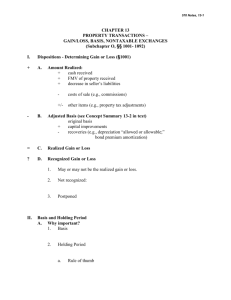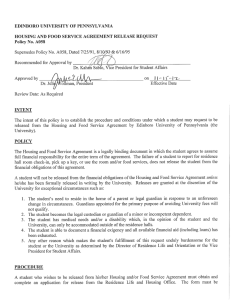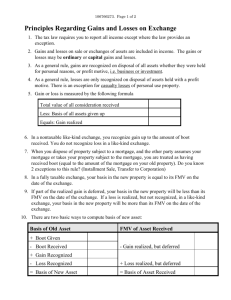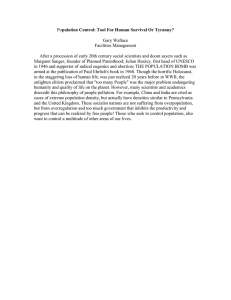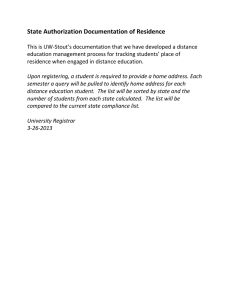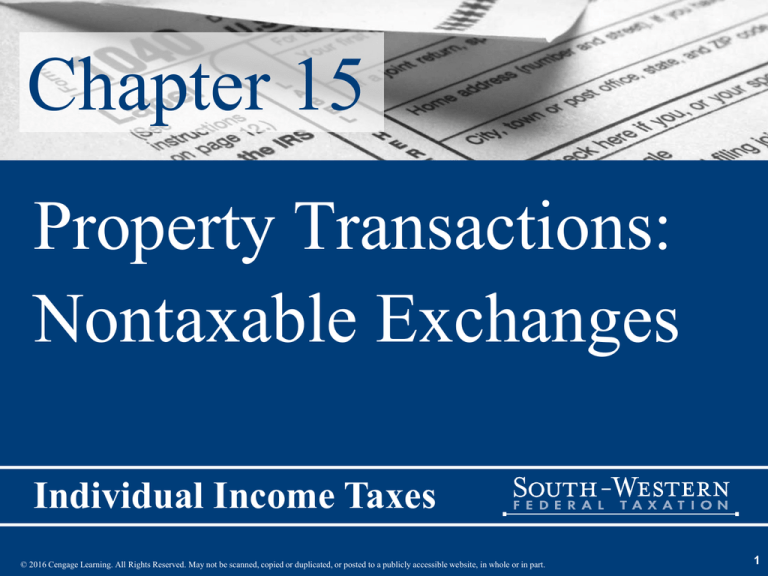
Chapter 15
Property Transactions:
Nontaxable Exchanges
Individual Income Taxes
© 2016 Cengage Learning. All Rights Reserved. May not be scanned, copied or duplicated, or posted to a publicly accessible website, in whole or in part.
1
The Big Picture (slide 1 of 3)
• Recall the situation introduced in ‘‘The Big
Picture’’ in Chapter 14.
• Alice has changed her mind about selling the
house to her nephew for $275,000.
– Due to a recent groundbreaking for an upscale real
estate development nearby, the appraised value of
the house has increased to $600,000.
• Alice has decided she needs to do something
with the house other than let it remain vacant.
2
The Big Picture (slide 2 of 3)
• She is considering the following options:
– Sell the house for approximately $600,000
• Sales commission will be 5%.
– Convert the house to a vacation home
• It would be 100% personal use by Alice and her family.
• Sell it in two years.
– Convert the house to a vacation home
• Rent it 40% of the time and use it 60% of the time for personal use.
• Sell it in two years.
– Sell her current home and move into the inherited house.
• She has owned and lived in the current home for 15 years
• Her gain on the sale would be about $200,000.
• Since she is nearing retirement, she would live in the inherited
house for the required 2 year minimum period and then sell it.
3
The Big Picture (slide 3 of 3)
• Alice expects the inherited house to continue to
appreciate in value by about 5% per year.
• She plans on retiring in two years and moving to a
warmer climate.
– Until then, she is neutral as to which house she lives in.
• What advice can you offer Alice?
• Read the chapter and formulate your response.
4
Nontaxable Transactions
(slide 1 of 4)
• In a nontaxable transaction, realized gain or
loss is not currently recognized
– Recognition is postponed to a future date (via a
carryover basis) rather than eliminated
5
Nontaxable Transactions
(slide 2 of 4)
• In a tax-free transaction, nonrecognition of
realized gain is permanent
6
Nontaxable Transactions
(slide 3 of 4)
• Holding period for new asset
– The holding period of the asset surrendered in a
nontaxable transaction carries over to the new
asset acquired
7
Nontaxable Transactions
(slide 4 of 4)
• Depreciation recapture
– Potential recapture from the asset surrendered
carries over to the new asset acquired in the
transaction
8
Like-Kind Exchanges
(slide 1 of 11)
• §1031 requires nontaxable treatment for gains
and losses when:
– Form of transaction is an exchange
– Assets involved are used in trade or business or
held for production of income
• However, inventory, securities, and partnership
interests do not qualify
– Asset exchanged must be like-kind in nature or
character as replacement property
9
Like-Kind Exchanges
(slide 2 of 11)
• Like-kind property defined
– Interpreted very broadly
• Real estate for real estate
– Improved for unimproved realty qualifies
– U.S. realty for foreign realty does not qualify
• Tangible personalty for tangible personalty
– Must be within the same general business asset or product
class
– Personalty used mainly in the U.S. for personalty used mainly
outside the U.S. does not qualify
– Livestock of different sexes does not qualify
10
Like-Kind Exchanges
(slide 3 of 11)
• When taxpayers involved in an exchange are
related parties
– To qualify for nontaxable exchange treatment,
related parties must not dispose of property
exchanged within the 2 year period following
exchange
– If such early disposition occurs, postponed gain is
recognized as of date of early disposition
• Dispositions due to death, involuntary conversions, and
certain non-tax avoidance transactions are not treated as
early dispositions
11
Like-Kind Exchanges
(slide 4 of 11)
• Exchange requirement
– The transaction must involve a direct exchange of
property to qualify as a like-kind exchange
– If the exchange is a delayed (nonsimultaneous)
exchange, there are time limits on its completion
• The new property must be identified within 45 days of
date old property was transferred
• The new property must be received by the earlier of the
following:
– Within 180 days of date old property was transferred
– The due date (including extensions) for tax return covering
year of transfer
12
Like-Kind Exchanges
(slide 4 of 11)
• Exchange requirement
– The transaction must involve a direct exchange of
property to qualify as a like-kind exchange
– If the exchange is a delayed (nonsimultaneous)
exchange, there are time limits on its completion
• The new property must be identified within 45 days of
date old property was transferred
• The new property must be received by the earlier of the
following:
– Within 180 days of date old property was transferred
– The due date (including extensions) for tax return covering
year of transfer
13
Like-Kind Exchanges
(slide 4 of 11)
• Exchange requirement
– The transaction must involve a direct exchange of
property to qualify as a like-kind exchange
– If the exchange is a delayed (nonsimultaneous)
exchange, there are time limits on its completion
• The new property must be identified within 45 days of
date old property was transferred
• The new property must be received by the earlier of the
following:
– Within 180 days of date old property was transferred
– The due date (including extensions) for tax return covering
year of transfer
14
Like-Kind Exchanges
(slide 5 of 11)
• Boot
– Any property involved in the exchange that is not
like-kind property is “boot”
– The receipt of boot causes gain recognition equal
to the lesser of boot received (FMV) or gain
realized
• No loss is recognized even when boot is received
15
Like-Kind Exchanges
(slide 6 of 11)
• Boot
– The transferor of boot property may recognize gain
or loss on that property
• Gain or loss is recognized to the extent of the difference
between the adjusted basis and the fair market value of
the boot
16
Like-Kind Exchanges
(slide 7 of 11)
• Basis in like-kind asset received:
FMV of new asset
– Gain not recognized
+ Loss not recognized
= Basis in new asset
• Basis in boot received is FMV of property
17
Like-Kind Exchanges
(slide 8 of 11)
• Basis in like-kind property using Code
approach
+
+
–
–
=
Adjusted basis of like-kind asset given
Adjusted basis of boot given
Gain recognized
FMV of boot received
Loss recognized
Basis in new asset
18
Like-Kind Exchanges
(slide 9 of 11)
• Example of an exchange with boot:
– Zak and Vira exchange equipment of same general
business asset class
– Zak: Basis = $25,000; FMV = $40,000
– Vira: Basis = $20,000; FMV = $30,000
– Vira also gives securities: Basis = $7,000;
FMV = $10,000
19
Like-Kind Exchanges
(slide 10 of 11)
Example (Cont’d)
FMV Property Rec’d
+Securities
Total FMV Rec’d
Less: Basis Property Given
Realized Gain
Boot Rec’d
Zak
$30,000
10,000
$40,000
25,000
$15,000
$10,000
Vira
$40,000
-0$40,000
30,000 *
$10,000
$ -0-
Gain Recognized
$10,000
$
-0-
*$20,000 Equip. + $10,000 Securities = $30,000
Securities: ($10,000 FMV - $7,000 basis) = $3,000 gain
recognized by Vira
20
Like-Kind Exchanges
(slide 11 of 11)
Example (Cont’d)
FMV Property Rec’d
Postponed Gain
Basis Property Rec’d
Zak
$30,000
-5,000
$25,000
Vira
$40,000
-10,000
$30,000
21
Involuntary Conversions
(slide 1 of 13)
• §1033 permits (i.e., not mandatory) nontaxable
treatment of gains if the amount reinvested in
replacement property ≥ the amount realized
• If the amount reinvested in replacement
property is < amount realized, realized gain is
recognized to the extent of the deficiency
22
Involuntary Conversions
(slide 2 of 13)
• Involuntary conversion
– Results from the destruction, theft, seizure,
requisition, condemnation, or sale or exchange
under threat of condemnation of property
• A voluntary act by taxpayer is not an involuntary
conversion
23
Involuntary Conversions
(slide 3 of 13)
• §1033 requirements
– Replacement property must be similar or related
in service or use as involuntarily converted
property
– Replacement property must be acquired within a
specified time period
24
Involuntary Conversions
(slide 4 of 13)
• Replacement property defined
– Must be similar or related in service or use as the
converted property
• Definition is interpreted very narrowly and differently
for owner-investor than for owner-user
– For business or investment real estate that is
condemned, replacement property has same
meaning as for like-kind exchanges
25
Involuntary Conversions
(slide 5 of 13)
• Taxpayer use test (owner-investor)
– The properties must be used by the owner in
similar endeavors
• Example: Rental apartment building can be replaced
with a rental office building because both have same use
to owner (the production of rental income)
26
Involuntary Conversions
(slide 6 of 13)
• Functional use test (owner-user)
– The property must have the same use to the owner
as the converted property
• Example: A manufacturing plant is not replacement
property for a wholesale grocery warehouse because
each has a different function to the owner-user
27
Involuntary Conversions
(slide 7 of 13)
• Time period for replacement
– Taxpayer normally has a 2 year period after the
close of the taxable year in which gain is realized
to replace the property
• Replacement time period starts when involuntary
conversion or threat of condemnation occurs
• Replacement time period ends 2 years (3 years for
condemnation of realty) after the close of the taxable
year in which gain is realized
28
Involuntary Conversions
(slide 8 of 13)
• Example of time period for replacement
– Taxpayer’s office building is destroyed by fire on
November 4, 2012
– Taxpayer receives insurance proceeds on February
10, 2013
– Taxpayer is a calendar-year taxpayer
– Taxpayer’s replacement period is from November
4, 2012 to December 31, 2015
29
Involuntary Conversions
(slide 9 of 13)
• Nonrecognition of gain: Direct conversions
– Involuntary conversion rules mandatory
– Basis and holding period in replacement property
same as converted property
30
Involuntary Conversions
(slide 10 of 13)
• Nonrecognition of gain: Indirect conversions
– Involuntary conversion rules elective
– Gain recognized to extent amount realized (usually
insurance proceeds) exceeds investment in
replacement property
31
Involuntary Conversions
(slide 11 of 13)
• Nonrecognition of gain: Indirect conversions
– Basis in replacement property is its cost less
deferred gain
– Holding period includes that of converted property
32
Involuntary Conversions
(slide 12 of 13)
• Involuntary conversion rules do not apply to
losses
– Losses related to business and production of
income properties are recognized
– Personal casualty and theft losses are recognized
(subject to $100 floor and 10% AGI limit);
personal use asset condemnation losses are not
recognized or postponed
33
Involuntary Conversions
(slide 13 of 13)
• Involuntary conversion of personal residence
– Gain from casualty, theft, or condemnation may be
deferred as involuntary conversion (§1033) or
excluded as sale of residence (§121)
– Loss from casualty recognized (limited); loss from
condemnation not recognized
34
Example 18 - Involuntary Conversion (slide 1 of 3)
• Walt’s business building (adjusted basis $50,000) is
destroyed by fire on October 5, 2014.
– Walt is a calendar year taxpayer.
• On November 17, 2014, he receives an insurance
reimbursement of $100,000 for the loss.
– Walt invests $80,000 in a new building.
– Walt uses the other $20,000 of insurance proceeds to pay
off credit card debt.
35
Example 18 - Involuntary Conversion (slide 2 of 3)
• Walt has until December 31, 2016, to make the
new investment and qualify for the
nonrecognition election.
• Walt’s realized gain is $50,000
– $100,000 insurance proceeds received − $50,000
adjusted basis of old building
• Assuming that the replacement property
qualifies, Walt’s recognized gain is $20,000.
– $100,000 insurance proceeds − $80,000 reinvested
36
Example 18 - Involuntary Conversion (slide 3 of 3)
• Walt’s basis in the new building is $50,000.
– This is the building’s cost of $80,000 less postponed gain
of $30,000
• $50,000 realized gain − $20,000 recognized gain
• The computation of realization, recognition, and basis
would apply even if Walt was a real estate dealer and
the building destroyed by fire was part of his
inventory.
– Unlike § 1031, § 1033 generally does not exclude
inventory.
• For this $30,000 of realized gain to be postponed,
Walt must elect § 1033 deferral treatment.
37
Example 19 - Involuntary Conversion
• Assume the same facts as in the previous example, except that
Walt receives only $45,000 of insurance proceeds.
– He has a realized and recognized loss of $5,000.
– The basis of the new building is the building’s cost of $80,000.
• If the destroyed building had been held for personal use, the
recognized loss would have been subject to the following
additional limitations.
– The loss of $5,000 would have been limited to the decline in fair
market value of the property, and
– The amount of the loss would have been reduced first by $100 and then
by 10% of AGI (refer to Chapter 7).
38
Sale of Residence
(slide 1 of 7)
• Loss on sale
– As with other personal use assets, a realized loss
on the sale of a personal residence is not
recognized
39
Sale of Residence
(slide 2 of 7)
• Gain on sale
– Realized gain on sale of principal residence is
subject to taxation
– Realized gain may be partly or wholly excluded
under §121
40
Sale of Residence
(slide 3 of 7)
• §121 provides for exclusion of up to $250,000
of gain on the sale of a principal residence
• Taxpayer must own and use as principal residence for at
least 2 years during the 5 year period ending on date of
sale
41
Sale of Residence
(slide 4 of 7)
• Amount of Exclusion
– $250,000 maximum
– Realized gain is calculated in normal manner
– Amount realized on sale is reduced by selling
expenses such as advertising, broker’s
commissions, and legal fees
42
Sale of Residence
(slide 5 of 7)
• Amount of Exclusion (cont’d)
– For a married couple filing jointly, the $250,000 max is
increased to $500,000 if the following requirements are
met:
• Either spouse meets the 2 year ownership req’t,
• Both spouses meet the 2 year use req’t,
• Neither spouse is ineligible due to the sale of another principal
residence within the prior 2 years
– Starting in 2008, a surviving spouse can continue to use the
$500,000 exclusion amount on the sale of a personal
residence for the next two years following the year of the
deceased spouse’s death
43
Sale of Residence
(slide 6 of 7)
• §121 cannot be used within 2 years of its last use
except in special situations, such as:
• Change in place of employment,
• Health,
• Other unforeseen circumstances
• Under these circumstances, only a portion of the
exclusion is available, calculated as follows:
Max Exclusion amount × number of qualifying months
24 months
44
Sale of Residence
(slide 7 of 7)
Effect of Renting on Principal Residence Requirement. The
renting of the taxpayer’s principal residence prior to sale does not
affect qualifying for the § 121 exclusion as long as the ownership
and occupancy requirements are satisfied.
•The residence thus does not have to be the principal residence on
the date of sale.
•Negative effect of renting. Any realized gain that is attributable
to depreciation is not eligible for the § 121 exclusion.
45
The Big Picture - Example 26
Sale Of A Residence - § 121 (slide 1 of 2)
• Return to the facts of The Big Picture on p. 15-1.
• Recall that one of Alice’s options is to sell her current
house and move into the inherited house.
• Assume that Alice, who is single, sells her current
personal residence (adjusted basis of $130,000) for
$348,000.
– She has owned and lived in the house for 15 years.
– Her selling expenses are $18,000.
– Prior to the sale, Alice pays $1,000 to make some
repairs and paint the two bathrooms.
46
The Big Picture - Example 26
Sale Of A Residence - § 121 (slide 2 of 2)
• Her recognized gain would be calculated as follows:
Amount realized ($348,000 - $18,000)
Adjusted basis
Realized gain
§ 121 exclusion
Recognized gain
$ 330,000
(130,000)
$ 200,000
(200,000)
$
–0–
• Since the available § 121 exclusion of $250,000
would exceed Alice’s realized gain of $200,000, her
recognized gain would be $0.
47
The Big Picture - Example 27
Sale Of A Residence - § 121
• Continue with The Big Picture and the facts of
Example 26, except that the selling price is $490,000.
Amount realized ($490,000 - $18,000)
Adjusted basis
Realized gain
§ 121 exclusion
Recognized gain
$ 472,000
(130,000)
$ 342,000
(250,000)
$ 92,000
• Since the realized gain of $342,000 > the § 121
exclusion of $250,000, Alice’s recognized gain would
be $92,000
48
Other Nonrecognition Provisions
(slide 1 of 6)
• Several additional nonrecognition provisions
are available:
– Under §1032, a corporation does not recognize
gain or loss on the receipt of money or other
property in exchange for its stock (including
treasury stock)
49
Other Nonrecognition Provisions
(slide 2 of 6)
• Under §1035, no gain or loss is recognized
from the exchange of certain insurance
contracts or policies
50
Other Nonrecognition Provisions
(slide 3 of 6)
• Under §1036, a shareholder does not recognize
gain or loss on the exchange of common stock
for common stock or preferred stock for
preferred stock in same corporation
51
Other Nonrecognition Provisions
(slide 4 of 6)
• Under §1038, no loss is recognized from the
repossession of real property sold on an
installment basis
– Gain is recognized to a limited extent
52
Other Nonrecognition Provisions
(slide 5 of 6)
• Under §1041, transfers of property between
spouses or former spouses incident to divorce
are nontaxable
53
Other Nonrecognition Provisions
(slide 6 of 6)
• Under §1044, if the amount realized from the
sale of publicly traded securities is reinvested
in common stock or a partnership interest of a
specialized small business investment
company, realized gain is not recognized
– Amounts not reinvested will trigger recognition of
gain to extent of deficiency
– Statutory limits are imposed on the amount of gain
qualified for this treatment
– Only individuals and C corporations qualify
54
Other Nonrecognition Provisions
(slide 6 of 6)
• Under §1044, if the amount realized from the
sale of publicly traded securities is reinvested
in common stock or a partnership interest of a
specialized small business investment
company, realized gain is not recognized
– Amounts not reinvested will trigger recognition of
gain to extent of deficiency
– Statutory limits are imposed on the amount of gain
qualified for this treatment
– Only individuals and C corporations qualify
55
Refocus On The Big Picture (slide 1 of 5)
• Alice needs to be aware of the different tax consequences of
her proposals.
• Sale of the inherited house.
– This is by far the simplest transaction for Alice.
– Based on the available data, her recognized gain would be:
Amount realized ($600,000 - $30,000)
$ 570,000
Adjusted basis
(475,000)
Recognized gain
$ 95,000
• Because the sale of the house is not eligible for the § 121
exclusion, the tax liability is $14,250 ($95,000 X 15%).
• Alice’s net cash flow would be $555,750
– $570,000- $14,250.
56
Refocus On The Big Picture (slide 2 of 5)
• Conversion into a vacation home.
– Only personal use.
• With this alternative, the only tax benefit Alice would
receive is the deduction for property taxes .
• She would continue to incur upkeep costs (e.g.,
repairs, utilities, insurance).
• At the end of the 2 year period, the sales results are
similar to those of a current sale.
• The sale of the house would not be eligible for the
§ 121 exclusion.
57
Refocus On The Big Picture (slide 3 of 5)
• Conversion into a vacation home
– 60% personal use and 40% rental use.
• Alice would be able to deduct 40% of the costs
– e.g., Property taxes, agent’s management fee, depreciation,
maintenance and repairs, utilities, and insurance.
– However, this amount cannot exceed the rent income generated.
• The remaining 60% of the property taxes can be claimed as an
itemized deduction.
• At the end of the 2 year period, the sales results would be
similar to those of a current sale.
• In determining recognized gain, adjusted basis must be
reduced by the amount of the depreciation claimed.
• The sale of the house would not be eligible for the § 121
exclusion.
58
Refocus On The Big Picture (slide 4 of 5)
• Sale of present home now with sale of inherited home in 2
years.
• This option would enable Alice to qualify for the § 121
exclusion for each sale.
• She would satisfy the 2 year ownership and the 2 year use
requirements, and the allowance of the § 121 exclusion only
once every 2 years.
• Alice must be careful to occupy the inherited residence for at
least 2 years.
– Also, the period between the sales of the 1st and 2nd houses must be
greater than 2 years.
• Qualifying for the § 121 exclusion of up to $250,000 would
allow Alice to avoid any Federal income tax liability.
59
Refocus On The Big Picture (slide 5 of 5)
• With this information, Alice can make an informed
choice.
• In all likelihood, she probably will select the strategy
of selling her current house now and the inherited
house in the future.
• A noneconomic benefit of this option is that she will
have to sell only one house at the time of her
retirement.
60
If you have any comments or suggestions concerning this
PowerPoint Presentation for South-Western Federal
Taxation, please contact:
Dr. Donald R. Trippeer, CPA
trippedr@oneonta.edu
SUNY Oneonta
© 2016 Cengage Learning. All Rights Reserved. May not be scanned, copied or duplicated, or posted to a publicly accessible website, in whole or in part.
61

